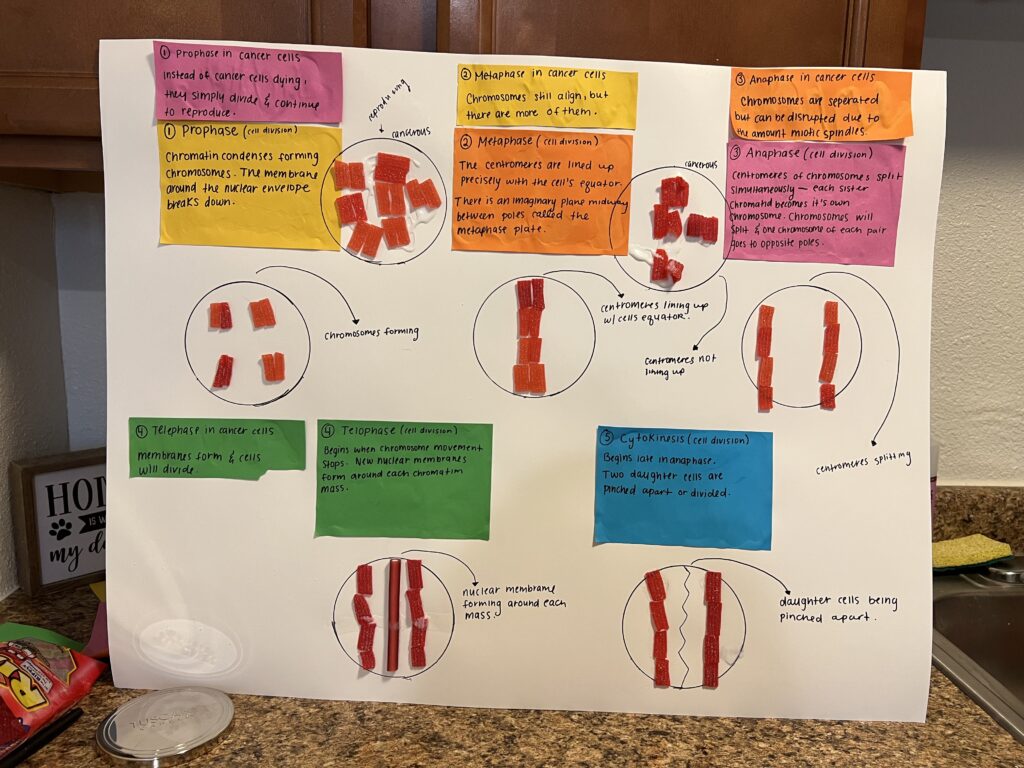
Mitosis and How it Affects Cancer Cells
Schyler Alexis Goers
BIOL F111L- Human Anatomy and Physiology
Professor Don Larson
July 27, 2023
Mitosis and How it Affects Cancer Cells
Throughout the semester we learned that mitosis is part of the cell cycle and while it generally seems pretty straightforward and consistent, cancerous cells are affected a little differently.
There are several different phases to mitosis and I demonstrated each phase in my STEAM Project using candies with the exception of interphase. Interphase is the first phase and this occurs before prophase. Interphase is the process in which cells make a copy of DNA prior to division. Next comes prophase and this is when chromatins condense which then creates chromosomes, and the membrane around the nuclear envelope breaks down (7.3: Mitotic Phase – Mitosis and Cytokinesis, 2018). In my project, I demonstrated mitosis in a regular cell versus a cancer cell and you can tell that the cancerous cell continues to reproduce and grow. This goes to show that the cancer cells never truly die and mitosis occurs infinitely (Mercadante & Kasi, 2021). Prophase is ultimately the first step in the meiotic process that can get messed up and this could lead to cancer. The next step is metaphase and in metaphase the centromeres are lined up with the cell’s equator. You can see on the project board that I demonstrated a non cancerous vs cancerous comparison. In the cancerous cell, you can see that the chromosomes are sort of aligned but there are more of them and they are not as precisely aligned with the cell’s equator than the non cancerous chromosomes are. Anaphase is the next step in the cell cycle, and this is when centromeres of the chromosome split and each sister chromatid becomes its each own chromosome, and each sister chromosome moves to opposite sides of the poles of the mitotic spindle (Bailey, n.d.). The next phase is telophase and this is the phase when the chromosomes come to a halt and stop movement, and new nuclear membranes forms around each chromatin mass (Telophase | Learn Science at Scitable, 2014). The last thing. The last thing I want to mention is cytokinesis. While cytokinesis is not really it’s own phase per say, it is still something that happens during the cell cycle. Cytokinesis is the division of cytoplasm in the two daughter cells. The daughter cells that result from this process have identical genetic compositions (Cell Division: Stages of Mitosis | Learn Science at Scitable, 2008).
It is very surprising to me that both cancerous cells and non cancerous cells still go through the same process of mitosis. The main difference that I realized throughout my research is that cancer cells never really die and they continue to reproduce and grow abnormal which ultimately creates a disarray in the body and this can lead to cancer, tumors, etc which as we know is extremely hard to treat and there really is no cure to stop this from occurring.
Citations
7.3: Mitotic Phase – Mitosis and Cytokinesis. (2018, December 21). Biology LibreTexts. https://bio.libretexts.org/Bookshelves/Human_Biology/Human_Biology_(Wakim_and_Grewal)/07%3A_Cell_Reproduction/7.3%3A_Mitotic_Phase_-_Mitosis_and_Cytokinesis#:~:text=The%20first%20and%20longest%20phase
B. A., B., & A. S., N. (n.d.). What Is Anaphase in Cell Biology? ThoughtCo. https://www.thoughtco.com/anaphase-a-cell-biology-definition-373298
telophase | Learn Science at Scitable. (2014). Nature.com. https://www.nature.com/scitable/definition/telophase-128/
Cell Division: Stages of Mitosis | Learn Science at Scitable. (2008). Www.nature.com. https://www.nature.com/scitable/topicpage/mitosis-and-cell-division-205/#:~:text=Telophase%20and%20Cytokinesis
Mercadante, A. A., & Kasi, A. (2021). Genetics, Cancer Cell Cycle Phases. PubMed; StatPearls Publishing. https://www.ncbi.nlm.nih.gov/books/NBK563158/#:~:text=Mitosis%20occurs%20infinitely.
